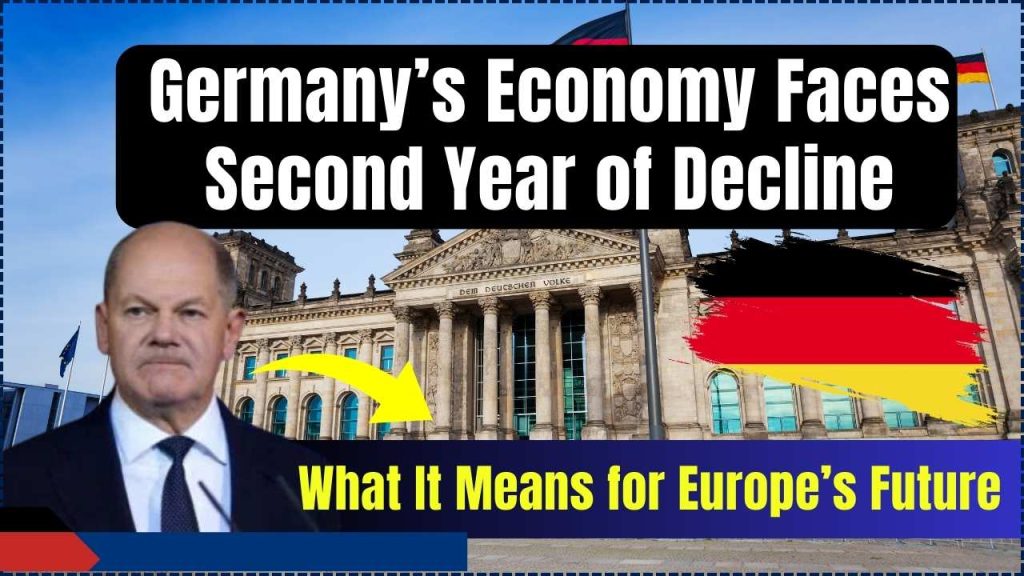
Germany’s Economy Faces Second Year of Decline: Germany’s economy has entered troubled waters, marking its second consecutive year of decline. This development is not just significant for Germany but for the entire European Union (EU), as the continent’s largest economy often sets the tone for the region’s economic health. Let’s explore why this is happening, what it means for Europe, and how stakeholders can navigate these challenges. With its pivotal role in shaping Europe’s economy, Germany’s trajectory will be crucial in determining the future of regional prosperity.
Germany’s Economy Faces Second Year of Decline
| Key Insights | Details |
|---|---|
| GDP Growth | Germany’s GDP shrank by 0.2% in 2024, following a 0.3% contraction in 2023. |
| Energy Costs | High energy prices, driven by reduced Russian gas supply, heavily impacted industrial production. |
| Interest Rates | The European Central Bank maintained rates at 4%, slowing investment in key sectors. |
| Political Instability | Early elections were triggered by the collapse of Chancellor Olaf Scholz’s coalition government. |
| Eurozone Impact | EU growth forecasts downgraded to 1.3% for 2025 due to Germany’s economic challenges. |
Germany’s economic challenges are a wake-up call for Europe. High energy costs, political instability, and global competition have created a perfect storm, but these challenges also present opportunities for innovation, collaboration, and reform. By embracing renewable energy, fostering innovation, and ensuring policy stability, Germany can not only recover but also pave the way for a stronger European economy. The coming years will determine whether Germany’s struggles become a catalyst for meaningful transformation or a prolonged period of stagnation.
What’s Driving Germany’s Economic Decline?
1. Energy Crisis
Germany has long relied on natural gas imports from Russia, but the geopolitical conflict involving Ukraine disrupted this relationship. The result? Energy prices surged, leading to skyrocketing production costs for Germany’s heavy industries, including automotive manufacturing and chemical production. For instance, energy-intensive industries reported a 15% drop in output during 2024. These elevated costs not only reduced profitability for manufacturers but also led to job losses, further straining the economy.
Example: A major German car manufacturer, Volkswagen, recently announced plans to scale down production in Europe due to escalating costs, shifting focus to overseas markets. Smaller suppliers, reliant on big automotive firms, have also felt the pinch, with many downsizing operations.
Germany’s reliance on fossil fuels underscores the urgent need for renewable energy solutions. Investments in solar and wind energy could alleviate these costs, offering a long-term solution to stabilize energy prices and protect industries from future shocks.
2. Global Competition
Germany’s export-driven economy faces stiff competition from China and the United States. In particular, China’s booming electric vehicle (EV) sector has made inroads into global markets, leaving German automakers scrambling to adapt. German brands, long considered the gold standard of automotive excellence, are now playing catch-up in the EV market.
Adding to this challenge, global supply chain bottlenecks have disproportionately affected German exporters. Delays and increased shipping costs have reduced the competitiveness of German products.
Practical Advice: To stay competitive, German industries need to ramp up investments in innovation and green technology, aligning with the EU’s Green Deal initiatives. Additionally, diversifying export markets to reduce reliance on traditional trading partners can provide more stability.
3. High Interest Rates
The European Central Bank’s decision to maintain interest rates at 4% has discouraged borrowing. This has hit German businesses hard, especially those reliant on capital-intensive operations, such as machinery and equipment manufacturing. Smaller enterprises, often regarded as the backbone of Germany’s economy, have reported reduced access to affordable financing, hindering their ability to expand or modernize operations.
Higher borrowing costs have also dampened consumer spending. With mortgages and credit becoming more expensive, households are tightening their budgets, contributing to reduced demand for goods and services.
4. Political Uncertainty
Chancellor Olaf Scholz’s coalition government recently collapsed over disagreements on economic policies, leading to early elections. This instability has further eroded investor confidence, with foreign direct investment (FDI) into Germany declining by 12% in 2024. The political vacuum has also delayed crucial reforms, leaving key sectors in limbo.
Investor sentiment often hinges on predictable policy environments. The current political uncertainty makes it difficult for businesses to plan long-term investments, further exacerbating the economic slowdown.
Why This Matters for Europe
Germany’s economic health is deeply intertwined with that of Europe. As the EU’s largest economy, Germany contributes significantly to regional growth, trade, and financial stability. Here are some key implications:
Supply Chain Disruptions
Germany is a linchpin in Europe’s supply chains, especially for sectors like automotive and machinery. A prolonged slowdown could ripple across the continent, affecting production timelines and costs. For example, neighboring countries like Poland and Hungary, which supply intermediate goods to German manufacturers, could face reduced orders, impacting their own economies.
Eurozone Growth
The European Commission has already downgraded its growth forecast for the Eurozone to 1.3% for 2025. Without Germany’s robust performance, achieving higher growth rates seems unlikely. This could also affect the strength of the euro, influencing trade and investment dynamics globally.
Investor Sentiment
Germany’s political and economic instability could deter investment not only within its borders but also in neighboring countries dependent on German markets. The knock-on effect could slow down innovation and development across Europe, as investors look elsewhere for stability.
How Can Germany and Europe Address These Challenges?
1. Energy Diversification
Germany must accelerate its transition to renewable energy sources, such as wind and solar, to reduce dependency on external suppliers. Government incentives and EU-wide collaboration can facilitate this shift. Beyond renewables, investments in energy storage solutions and grid modernization are essential to ensure a reliable supply of electricity.
Practical Example: Subsidizing renewable energy projects could make green electricity more affordable for industrial users. Similarly, public-private partnerships can drive the adoption of innovative energy solutions, fostering sustainability and resilience.
2. Boosting Innovation
Investing in research and development (R&D) is crucial for maintaining competitiveness. Germany should focus on high-growth sectors like EVs, artificial intelligence, and biotech. Supporting start-ups and small businesses in these fields can also create new opportunities for job growth and economic diversification.
3. Policy Stability
Political leaders must prioritize economic reforms to restore investor confidence. Proposals like tax cuts, reducing bureaucracy, and streamlining permitting processes could stimulate growth. Germany’s Mittelstand companies (small and medium enterprises) would particularly benefit from reduced administrative burdens.
Example: France’s success with similar policies under its “France Relance” plan serves as a blueprint. Clear timelines and actionable reforms can help Germany regain its footing.
4. EU Collaboration
The EU can step in with coordinated fiscal policies and investment initiatives to counteract the economic slowdown. For instance, expanding the EU Recovery Fund could provide much-needed financial support to struggling industries. Collaborative projects, like pan-European infrastructure upgrades, can also drive long-term growth.
Denmark’s 2025 Workforce Recruitment List Includes 162 New Jobs – See If You’re Eligible to Apply!
High-Paying Jobs in Australia in 2025: How to Apply? Check Eligibility & Job Profile
Top 10 Highest-Paying Jobs in the UK: Explore Current Salary Trends Across Industries
Frequently Asked Questions About Germany’s Economy Faces Second Year of Decline
1. Why is Germany’s economy shrinking?
Germany’s economy is shrinking due to high energy costs, global competition, elevated interest rates, and political instability. Each of these factors has compounded the challenges facing Europe’s largest economy.
2. How does Germany’s economic health affect Europe?
As Europe’s largest economy, Germany’s performance significantly impacts the EU’s overall economic growth, supply chains, and investor confidence. A struggling Germany often means slower growth for the entire region.
3. What can businesses do to navigate these challenges?
Businesses can invest in green technology, diversify their markets, and advocate for policy reforms that reduce costs and improve competitiveness. Collaboration with government initiatives can further bolster resilience.
4. What role does renewable energy play in Germany’s recovery?
Renewable energy is crucial for reducing production costs and achieving energy security, making it a cornerstone of Germany’s economic recovery strategy. Adopting renewables can also align with Germany’s climate goals.











